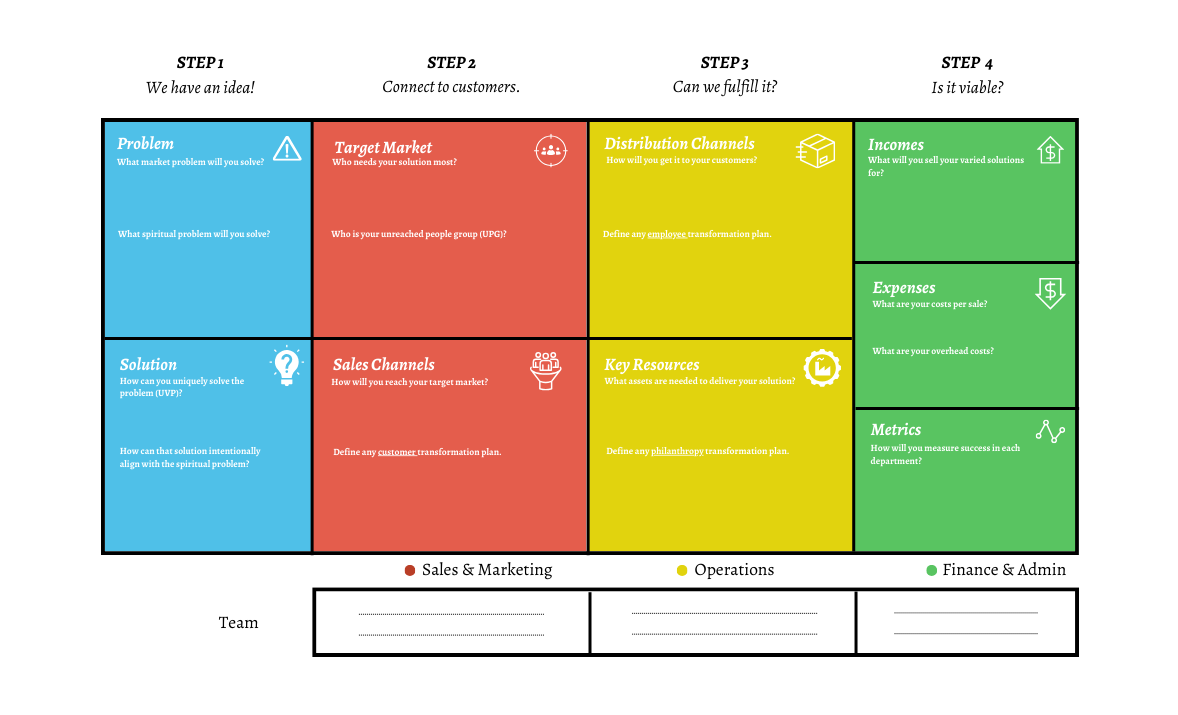If you’ve ever developed a business plan, you’re probably familiar with the overwhelming task of researching, writing, and late nights drinking copious amounts of coffee or whatever your favorite energy drink is just to stay sane amidst the never-ending process. On the other hand, you may be one of those freewheeling, gung-ho entrepreneurs that just got an idea in the shower, and moments later you were ripping the carpet off the floor to build your new tap-dancing and karaoke studio. No plan. Just total grit and will-power to stand up your idea in spite of the overwhelming evidence that there is no market for a tap-dancing and karaoke studio… “at least, not yet,” you say.
Whether you’re the planner or the not-so-planned, I want to encourage you to begin your business with the use of a one-page, business model template. You may be familiar with a tool called the Business Model Canvas (BMC). This business modeling framework was first proposed in the PhD thesis of Alexander Osterwalder, and it is an excellent resource for mapping existing corporations and what makes them innovative. What we will describe here is called the Business for Transformation (B4T) Canvas. (For more detail on B4T and its sister terms, check out our diagram here.)
Download blank template here.
The B4T Canvas is a template for mapping Business as Missions (BAM) structures that are focused on reaching Unreached People Groups (UPGs). Its purpose is to walk you through the start-up process, plan for initial stages of growth, and define how your missions work will intentionally integrate with the business you engage in. Let’s begin.
Step 1: We have an idea!
The first step in developing your transformational business is to determine a market need. Where is there an opportunity? We often start with a solution and then retrofit our ideas into a problem area that is backed up by a little bit of data. I want to challenge that approach as we begin the model here by first defining the problem that is being solved. Starting here will get us to an idea that has real, lasting promise in the marketplace – and let’s not forget, if you’re starting a B4T, a lasting business is probably key to a lasting ministry.
Problem. The problem with most businesses is that most of us do not start with the problem. Does that make sense? When you think of your brilliant tech innovation or that fancy new pastry for your bakery, it is absolutely essential that you ask yourself, “Does anyone need this?” or “Am I actually solving a problem with this innovation?” Just because I cannot find cookies in the shape of Disney characters at any of my local stores does not mean that this is somehow a problem that needs to be addressed.
When we think about defining the problem in a new business, it is critical that we assess what needs drive demand first. So your friend wants a tumbler that holds 6 gallons of liquid. If you’re going to open a factory, you better do some market research and collect a lot of data that backs up the several million dollar budget that takes!
Define the need. Are eggs too expensive at your local supermarket? Are they too processed? Too small? Too brown, and the ratio of egg white to yoke is just all wrong! If you’ve come this far and you have data in hand to support your thesis, you’re probably ready to begin crafting a solution… I know. I know. You already have. We’re just backfilling data. Right? Well, things could be worse for our new business I suppose.
The second part of this process is writing down the spiritual problem that your business is simultaneously purposed for. In a B4T, this is likely that there are people in the area who have never heard the good news of the gospel. It can also include things such as lack of biblical education, Christian literature, trained pastors, church buildings, etc. if you see these as spiritual problems that your business will be involved in solving. By definition, however, a B4T must at least include unreached people in the spiritual problem.
Solution. More likely than not, you probably started your planning with the solution, and that’s okay. Most entrepreneurs start with a personal aspiration like, “I want to make a lot of money” or “I want to be my own boss.” Since you are filling out the B4T Canvas, however, you probably started with something like, “How can I reach this people group effectively with the gospel?” or “How can I practically share my faith in a country that doesn’t give out missionary visas?” Often start-ups begin, not because a potential customer has a problem, but because the future business owner has a need and intends to solve it by starting a business. It’s okay to start with your need as the business owner. However, my challenge to you is that you research and test your business ideas to ensure that you are in fact solving a market need rather than building a business and hoping people will come. Put simply, your problem, or reason for starting a business, will not be solved unless you provide a solution to someone else’s problem.
On its face, providing a solution to a problem may seem obvious, but let’s take it a step further. Imagine some business people who may want to eat lunch fast and get back to work. So you open a fast-food restaurant. Great! But what if there are a dozen fast-food restaurants just like yours within a two minute walk? What makes you think that anyone will go to your restaurant instead of theirs? Are they even busy? Or are they more than capable of solving that problem for everyone in the area who has that need?
There are two elements at work here. One is saturation. If the market is overly saturated, it may be a good idea to steer clear of the fast-food restaurant idea. But that is the less important of the two. The other element is what we call a Unique Value Proposition (UVP). A value proposition is to say, “We offer fast-food.” But a unique value proposition is to say, “We offer the fastest service in town!” Or maybe, “The highest quality fast-food in the city.” Do you see the difference?
When you fill out your solution box, make sure that you begin jotting down possible UVPs that your business could have. You may not know at first where you will shine, but your best chance at success will only be possible if you offer a unique solution to the problem.
The goal is to develop a solution that goes hand-in-hand with your vision for transformation. This is your ministry approach. How are you going to intentionally bring transformation through your business? Use this section to begin strategizing how you will make an impact.
Typically there are three categories for transformational impact: employees as mission, customers as mission, or philanthropy as mission. Will the business focus on scaling its operation to minister to as many employees as possible? Will your business create lots of deep relationships with customers as a ministry focus, such as a barbershop or gym with personal trainers? Or, will you impact your community more externally through philanthropy? Many secular businesses have a budget for corporate social responsibility (CSR) in a similar model, with donated profits and community service as brand-boosting outlets for their company. In every case, the goal is gospel proclamation, discipleship, church planting, and/or similar spiritual impacts (Romans 10:14).
It can be easy to fall into the trap of simply saying things people want to hear and hoping that the Holy Spirit will nudge them in spite of our words. This might be a good time to point out that Francis of Assisi never said those infamous words, “Preach the gospel at all times. Use words if necessary.” Remember, “love is not self-seeking” and, it “rejoices with the truth” (1 Cor. 13:5-6). It is sometimes uncomfortable to show real love, it is occasionally offensive, and it is certainly never proud or self-righteous.
Now, I want stress how important it is that the market needs and spiritual needs must be intentionally integrated with each other. Years of business as missions has shown beautiful business models as well as plenty of ugly ones. The ugly ones are what we call “job fakers,” and this is much like it sounds. The business must be a legitimate, profit-intent problem solver in the community and not a shell company, or worse, money laundering hub. Let us be “job makers” – to the glory of God! Starting and operating a business in your home country is hard enough. Doing ministry in your home country is hard enough. We do not have time to split our time between faking business and creating ministry opportunities. The two and they should not be separate. There is no sacred/secular divide in the kingdom of God.
Our friend Dick Brogden once said, “…business is not just pragmatic, but it’s powerful, because it’s continually propelling us into new conversations, relationships, and opportunities where we can proclaim Christ, find those who are interested, and then drill down into discipleship with them.”
That is B4T. That is transformational business. It is marrying our mission to the marketplace in a beautiful dance that doesn’t result in burn out, fake business, or daily runs to the bank to keep the neglected structure afloat. Your transformational plan should display the opportunity to share the gospel in a business context rather than forcing the issue into a model that is ultimately waging war against your soul.
One more caveat. Intentional integration of business and ministry does not mean that ministry can only happen in and through your business. For many people, the business does provide relationships, but the relationships grow deeper as you hangout outside of work or over a meal in your home. You can clock-out of your job, but a Christ follower does not clock-out of following Christ.
Read Part 2 of the B4T Canvas Here



